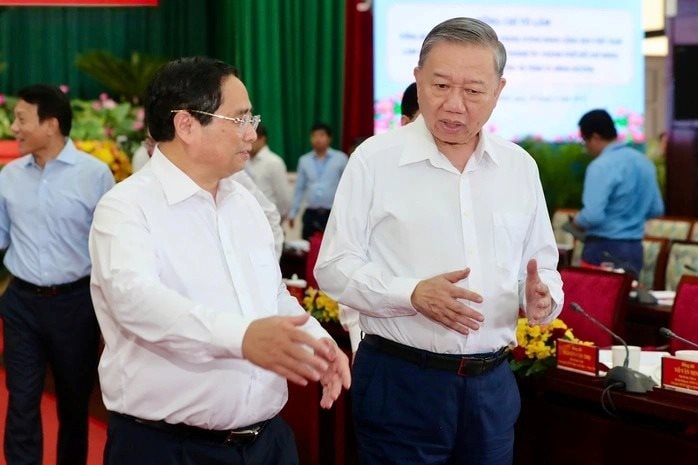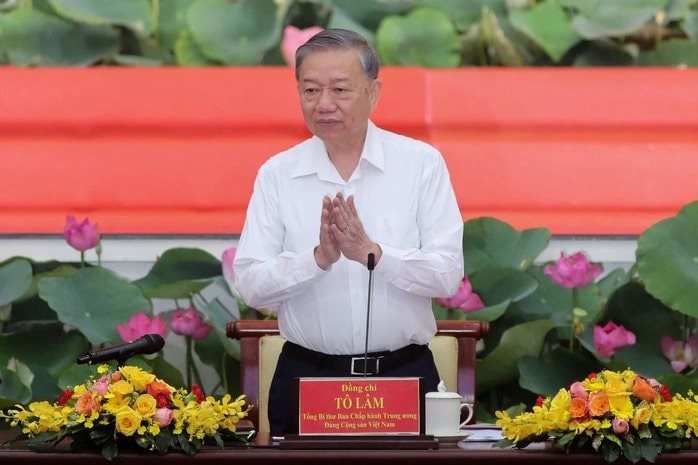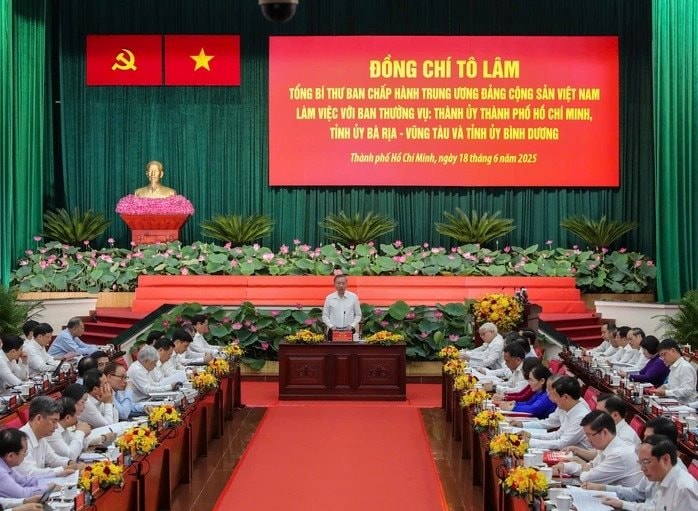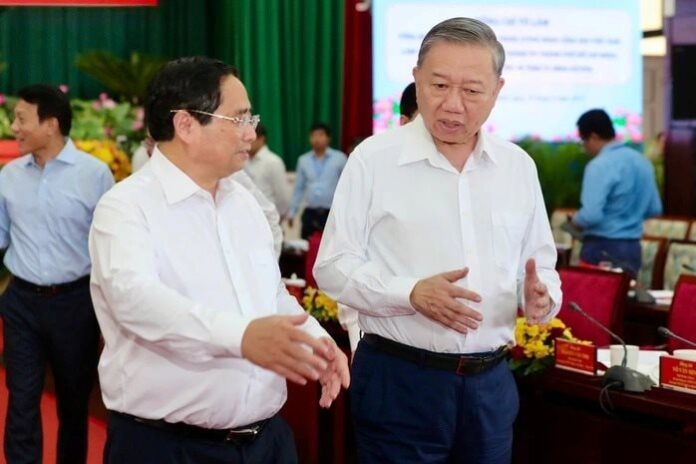
General Secretary To Lam and Prime Minister Pham Minh Chinh at the meeting. Photo: HT
The city that will become this “international metropolis” is new Ho Chi Minh City.
On June 12, the National Assembly passed a resolution on the rearrangement of administrative units at the provincial level in 2025, reducing the number of provinces and cities in Vietnam from 63 to 34. As part of this resolution, Ba Ria-Vung Tau province, Binh Duong province, and Ho Chi Minh City will be merged, and the new entity will be named Ho Chi Minh City. The political and administrative center will be located in the current Ho Chi Minh City. Post-merger, the area of new Ho Chi Minh City will be over 6,770 sq. km, placing it among the largest urban areas in the region, comparable to Jakarta (7,600 sq. km) and Bangkok (over 7,700 sq. km), and larger than Shanghai (over 6,300 sq. km). The new city’s population will be over 14 million, and it will comprise 168 administrative units, including 113 wards, 54 communes, and 1 special district.
Vietnam’s Potential Mega-City of Finance, Industry, and Seaports
Today (June 18), a Central Working Delegation led by General Secretary To Lam had a working session with the Ho Chi Minh City Party Committee, Ba Ria-Vung Tau Provincial Party Committee, and Binh Duong Provincial Party Committee in Ho Chi Minh City.

General Secretary speaking at the meeting. Photo: HT
At the meeting, the General Secretary emphasized that the integration of Ho Chi Minh City with Ba Ria-Vung Tau and Binh Duong marks a historic turning point in the development of Vietnamese urban areas. This is a comprehensive reconfiguration of the development space, where three of the country’s most dynamic economic centers converge to form a mega-city of finance, industry, and seaports.
According to the General Secretary, the new vision for Ho Chi Minh City is to become an “international metropolis” of Southeast Asia, a smart, green, and creative city, distinguished not only by its economic strength but also by its rich culture, arts, sports, entertainment, and modern, dynamic lifestyle. New Ho Chi Minh City aims to be a regional hub for finance, commerce, logistics, high-tech industries, and sea tourism, with a development orientation based on digital technology, green economy, environmental sustainability, social harmony, openness, and civility, incorporating the advanced values of Asia and the world.

General Secretary expects new Ho Chi Minh City to set specific goals. Photo: HT
Ho Chi Minh City aspires to be an attractive hub for talent, “creative individuals,” and entrepreneurs from Vietnam and abroad, offering a conducive environment for innovation and start-ups, incubating new trends, and pioneering advanced models. The General Secretary emphasized that the new Ho Chi Minh City should not only be the economic locomotive of the nation but also a modern metropolis with global influence.
Therefore, the General Secretary requested that new Ho Chi Minh City proactively set specific goals for itself: By 2035-2045, where will its income rank among Asian and global cities? Where will it stand in terms of innovation and creativity in Asia and the world?
Additionally, the General Secretary suggested that new Ho Chi Minh City promote the building of a robust ecosystem for science and technology, innovation, and the private economy, not just in words but through concrete actions. Moreover, the city should remain steadfast in its goal of holistic human development, closely linking economic growth with social progress, equality, and quality of life. Beyond being an economic hub, new Ho Chi Minh City must become a livable city, ensuring that every resident has access to opportunities for development and enjoys comprehensive care in terms of health, education, living environment, and safety.
In 2024, Ho Chi Minh City ranked second in the Digital Transformation Index, while Binh Duong ranked seventh. Ba Ria-Vung Tau ranked second in administrative reform and fifth in the Provincial Competitiveness Index (PCI). Additionally, Binh Duong is among the top three localities with the most effective implementation of free trade agreements and ranks fifth in the Green Index.
Recently, the People’s Committees of Ho Chi Minh City, Binh Duong, and Ba Ria-Vung Tau had a working session to unify the plan for arranging the apparatus, departments, and public non-business units of the three localities to be ready to operate the model of two-level local government from July 1.









































